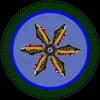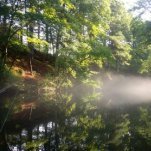-
Content Count
298 -
Joined
-
Last visited
-
There, think I figured it out. These are from a put & take water and came home for dinner.
-
Voted most don't have bead heads, I rarely use them and when I do it's usually just to get a lighter nymph deeper in faster water.
-
It doesn't show the photos. Try uploading from the computer to the forum. Yeah, was trying to figure it out on the phone, no more computer, any phone apps to resize the image?
-
Not sure if this link idea will work but caught a nice brook trout and brown this evening. Haven't been hanging out here much recently or fishing but it was nice to get away from the kiddos for a couple hours and hit a stream, especially when the fish were feeding like they were tonight. https://photos.app.goo.gl/VfEAas392hw2RHDB3
-
Trolling can be a good technique (and I did a lot of it before I started fly fishing). The two most important factors are the depth the fish are holding at (mostly dependent on temperature and dissolved oxygen) and an understanding of the bottom structure of the lake (big rocks, gravel shoals, basins, springs) which comes with time and using a depth finder/depth maps. In places I used to troll frequently I could pretty much guarantee you a fish because I knew where the bottom structure was ideal. Another big factor is trolling speed, for trout and salmon somewhere between 2 and 5mph is good. In one pond I fly fish the best fly fishing territory is at the opposite end of the pond from the boat landing, while I paddle down there I troll with my entire fly line out and take a route over several rocky 'underwater islands' which lands me my first couple of fish almost every trip. If the surface water is cold and maybe there is some chop I fish full float line with a lightweight streamer on 6-8' of leader/tippet, as the surface water warms throughout the summer I gradually work my fly's deeper, with standard fly fishing gear 10' is about as deep as you can effectively troll. Knowing the bottom structure is really the key to successful trolling for most fish species, even if it the surface is cool and well oxygenated fish will hang out around the good habitat that may be 20-30' below. If you're just randomly cruising around the lake you are just going to randomly catch fish, if you're trolling over productive fish habitat you'll catch fish. Around this time of year, when the ice goes out, underwater basins will be full of 39 F water (the temperature at which water is most dense), which is also usually the warmest water for a while after ice out, and fish will congregate in these basins. Finding one that is 20' deep with a 10-15' deep surrounding area is prime, get a size 6-2 streamer down to 8-10' and trolling over those basins can be very productive (or not trolling at all and just casting and retrieving over it). I hold my rod straight out from the boat with the tip close to the water, the tip will develop a rhythmic bounce at a constant speed and I watch for it pull hard or stop bouncing, quick sets are key when trolling. Size 2 7xl Rangeley style streamers are very popular to troll with here in Maine.
-
A few Hendrickson variations tailored to my local waters for the hatch that will be starting when the water warms up a little.
-
Got mine in the mail today, thanks all. And thanks for taking the time to do those critiques Henrik, makes the whole idea of the swap worthwhile. Perhaps I will be able to make some time this weekend to do some critiques also. And as I hinted at earlier breambuster I will not be joining the next round for fear that I won't be able to hold up my end with my two babies needing my time and attention, hopefully when they get older they'll want to learn to tie and I'll get plenty of time at the bench with them. Can't wait to see all the classic wet flies though, I used to tie quite a few of them when I had lots of time at the bench. For anyone thinking of tying a pattern with married wings I suggest doing a few practice flies and developing a method for yourself to keep track of the feathers (because you want a left side wing left side of feather of one color married with the left wing left side of the other color and vice versa for the right side). What I do if I'm tying a bunch of one pattern is make all the wings first, I take a feather of the two or three colors I'm going to marry from the same side of the bird and cut from the same side of each feather then line the tips up, marry them, and set them on a plate (or in a container if I will not be doing it in one sitting). This just keeps down on the frustration of having feathers that don't line up or won't marry, which makes it much easier especially for someone who hasn't done it before. (If that seems wordy and confusing watch a video on marrying feathers and you'll see what I mean by left side with left side.)
-
The hackle on mine is from a blue winged teal, a type of duck. It does tend to marry itself when dry, but once it's sitting in a little current the fibers will lay around the body (fairly evenly if I tied them halfway decent) and trap some air bubbles. Teal feathers are very soft, they look great IMO, but they usually only handle a few good fights before they tear off, but they are one of my favorite soft hackles for coloration and motion in the water.
-
My favorite technique for small stillwaters is sight fishing during a hatch. Most small ponds up here (Maine) have something hatching at dawn and dusk every day and other hatches during the day but the trout are weary of rising in bright sunlight. I prefer the hatches at dusk (light when I walk in and get set up and find the hatch, and the trout are hungry from being primarily hunkered down during the day). I usually have a collection of flies that are general imitators, mostly EHC in lots of colors and simple mayfly patterns (tail, dubbing, hackle) in many colors. My EHC go from size 12-18, and mayflies from 16-22. I also have some general midges like the griffiths gnat (14-26). If the water is small enough to walk around within a few minutes or less I try to scope out underwater features during daylight. and find places that can keep me mostly out of sight. Casting is usually the biggest challenge because the trees grow right out over the water and wading in the smallest waters can spook the entire pond with one misstep. I also usually let the fly sit a good while before recasting so that my casts don't spook the fish.
-
If you don't hear anything back breambuster, as always you can keep the extra fly.
-
Got my flies in yesterday, nice bunch of nymphs. I definitely need to find a better method of judging proportions on the articulated flies, the legs and tail did come out pretty long. No glue, but the mono I used was probably to big, and thus they are tight moving. If I tie them again for something I'll probably just use 4lb mono, all the recipes called for heavier though and I went with it. I learned a lot about articulated nymphs, so maybe in a future swap someone will get a more refined fly. Thanks for the idea BB and to everyone for a nice little set. When will the soft hackle due date be? If it's a ways off I think I can fit in one more swap before the next addition to my family arrives.
-
I've been to my local fly shop several times recently and noticed the Keough Grizzly Saddles they had in stock were displaying a lot of nice red/brown mixed into the Grizzly, I wouldn't quite call it Cree (of what I understand Cree is) but I know there are quite a few tiers out there looking for Cree, and I think Keough may be close to getting it. I almost bought one just to post a photo. They had 6 grizzly saddles out on the rack and all of them had a varying degree of the Cree look. They are $45 at my shop which sounds like a steal compared to the prices I've heard some people paying for Cree hackle. If your in the market for some I''d dig through the Keough Hackle if they carry it at you local shop.
-

Anyone have any links to weaving flys
kennebec12 replied to StoneFlyTyer's topic in The Fly Tying Bench
Search Shuttle Weave on the forum here, Crackaig did a great tutorial on weaving a while back. Should at least get you pointed in the right direction. -
Pretty much anywhere in the North East we refer to ruffed grouse as partridge. It's one of those odd words that has become a general term for the bird we hunt locally, though truly partridge are a group of species of pheasant like birds in Southern Europe and the Middle East. Grouse are actually distant relatives of partridge, but probably the name was used because they are similar in size and shape and were recognizable to early explorers. Woodcock have nice feathers, generally a little stiffer stemmed than Hungarian partridge but softer than pheasant, the color is quite a bit different also and as far as I've fished with woodcock it's been less productive than the same fly tied with partridge (which I believe is because the tan/brown color doesn't match the naturals as well as the gray/brown partridge where I fish). Woodcock feathers can be pretty short (and thus a pain to tie with) but I keep most of the feathers off the one or two I get every year. The one I got last fall had nice long feathers on it, which have been much easier to use. They are tough to hunt, their camouflage is near perfect, I go out in the field and wait for them to fly at dusk (5-10 minutes before the end of legal hunting hours they all take off and fly in a circle) and that's the only way I've been able to get them. Very little meat but they are some tasty.
-
I just did a set for the first time for the skill builder swap. Most of the flies I looked at for reference had a tail about or just under a hook shank (one hook) the rear hook was the abdomen and the front hook was the thorax and the legs extended to either the end of the first hook or to about midway through the second hook, the legs were by far the most difficult part to get right.

